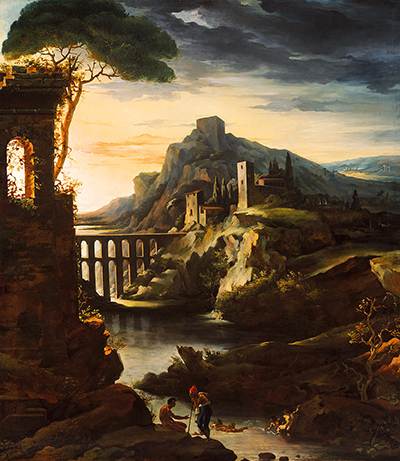Theodore Gericault painted this to form a set of four monumental landscapes in 1818. They were produced during summer in Paris, and the original intent appears to have been to accurately yet imaginatively capture four different times of day as viewed from the artist's studio window. Only three of the set: Morning, Noon and Evening were ever completed.
It is apparent that this set of paintings were conceived as decor, perhaps in similar manner to Claude Joseph Vernet, whose brush strokes captured detailed observations of landscapes for display in the palaces of Rome. Gericault's four phases of the day may have been intended to adorn the Salon, yet it is not known whether the three that survive were painted in response to a commission. It is possible to date the works through receipts for delivery of the canvases to Gericault's studio.
Plunge into Gericault's aqueduct landscape and it is possible to identify a tangible location: the aqueduct at Spoleto in Italy, which forms the centre point of a well preserved medieval papal fortress. Harking back to the medieval era is in some ways characteristic of the emerging aesthetic of Romanticism, as are other discernible tenets of the painting. Gericault's experiences were emotionally intense: at the time of painting, he was awaiting the birth of a child whom he himself had fathered, to his uncle's second wife. This turmoil is rendered visible in the way the light swells behind the window of a ruin, from which tendrils of ivy protrude, and in how these warm colours contrast to the inky depths of Gericault's sky.
The way Gericault has captured light is dramatic, yet not entirely comfortable. His craggy river ravine, and the blue shadows of mountains receding behind the hill fortress, are in keeping with notions about the sublime: of the world's greatness, and its extremes of colour, light and emotions. Theodore Gericault specialised in the use of very fine, intricate brush strokes, and this is exemplified in the way his Evening - Landscape with an Aqueduct details the colour and texture of the ivy tendrils that gave grown over the ruins, the fiery warmth of the dying sun behind the gaunt shape of a tree, and the heaviness of every threatening cloud.
Gericault was also renowned for the way he contrasted ochre and peach with black and beige; these are warm colours, to render visible passionate emotions. There are examples of this visible in his evening tableau, where the observer gains a real sense of a quietly molten sunset. Another characteristic of Gericault discernible in this painting is the detail of the human figures' posture, even though here, they are in the painting's background rather than the foreground.




